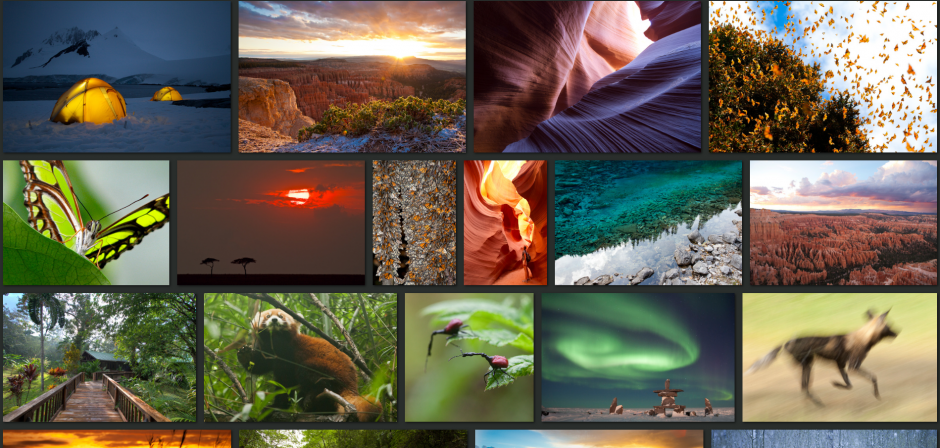
New Year, New Travel Photo Tips for 2020
If you’re like many, 2020 will bring you some exciting nature travel plans, whether it’s getting out to your local city or state park more often, or perhaps you have a big adventure to some iconic wildlife area of our world. And if you’re like me, you’re going to want to photograph whatever you get into, near or far.
Whether you’re headed to Alaska to photograph brown bears at close range, or all the way across the world to the Himalayas, here are a few travel photography tips to ensure that you’re coming home with the best images possible during any journey.

Your camera kit should be a balance of versatility and specificity
When traveling, you will ALWAYS benefit from having less. This goes for suitcases, just as it does for camera gear. Thus, I’m a big fan of zoom telephotos that give you ranges for maximum versatility. However, at the same time, there are some really nice specialty lenses out there like ultra-wides, nifty fifties, and macro lenses. by the time you cover your wide angle range with one lens, and a decent telephoto, you can probably have space for one more lens—this is what I often refer to as an “X-Factor” lens. If you want to read more on this concept, take a look at my article on What is an X-Factor Lens.
Specialty lenses can give you that unique look so desirable in travel photography.

If you learn anything new, it should be to best harness depth of field
Once you harness some of the basics of composition, and understanding the virtues of good lighting in your photography, it’s time to master depth of field.
Depth of field refers to how much you have in focus in your scene. Photos with a wide depth of field have lots in focus, while conversely, photos with shallow (aka narrow) depths of field have very little in focus. And all of this is governed by your aperture and f/number in your camera. If you shoot on auto, or P settings, your camera is choosing this for you. That’s fine, but to be in real control you should be the one dictating to your camera what depth of field you’d like.
Let’s just say in general, an aperture of f/5.6 is pretty average. Not really wide, not really narrow. Thus, any f/number less than this begins to give you a narrower depth of field, and anything greater gives you a wider depth of field.

The best way to look at depth of field is a slice of focus. That is, whatever you’re actually focusing on will always be in focus, no matter the depth of field. However, how much is in focus in front or behind that spot entirely depends on your aperture and f-stop. Every time you increase the f/number, you’re adding a little more focus in front and a little behind your focus point.
There are MANY reasons why you might want either narrow/shallow depth of field or a really wide one. Generally speaking, portrait/wildlife shots are best with narrow DoFs (we’ll get fancy and abbreviate depth of field here), and landscape shots are best with a wide DoF.
However, rules are ALWAYS meant to be broken. If you wish to read more on this and make 2020 the year to master this technique, read here on my Apertures and F-Stops page.

Make sure your photos are as sharp as possible
Nobody likes a blurred photo. Not the person you’re showing your photos off to, and DEFINITELY not you, as you review your photos from some amazing wildlife spectacle. There is perhaps no worse of feeling than to have just experienced something amazing, have your camera actually with you, be in position at the right place and right time, yet most of your photos are blurry.
The vast majority of the time your culprit is not having a fast-enough shutter speed.
There are some simple rules to follow on how to get a “fast enough” shutter speed, so I invite you to read more on my Shutter Speed page here.

Practice, practice, practice
It’s easy to say, and sometimes it’s hard to find the time, but it’s absolutely critical. If you wish to steadily improve on your photography, you have to practice. Fortunately, practicing photography is just as fun as actual photography because IT IS!
The biggest trick is that you should bring your camera everywhere with you. Ok, maybe not to the grocery store, or Sunday afternoon errands, but anytime you’re going somewhere pleasurable, you should absolutely bring your camera with you. Even if you don’t take many shots, you’ll be thinking about photography and helping to train your eyes to see photo opportunities. As I often say when thinking about light, you must train your eyes to properly see the slight differences from day to day, place to play, and season to season. Bringing your camera with you most of the time is a great way to remind yourself to be thinking about light (as well as general photo opportunities).
Keep Learning!
As always, throughout the year I’ll be publishing new articles on key tips and advice on photographing in our wild world. If you like travel, nature, and wildlife, and LOVE to capture it through your lens, stick with us here in 2020, subscribe, and keep learning new things each week. And if you have any questions I can personally answer for you, please leave a comment below and I’ll be sure to get to it between expeditions!
Cheers, and Happy 2020!

Court
Leave a reply